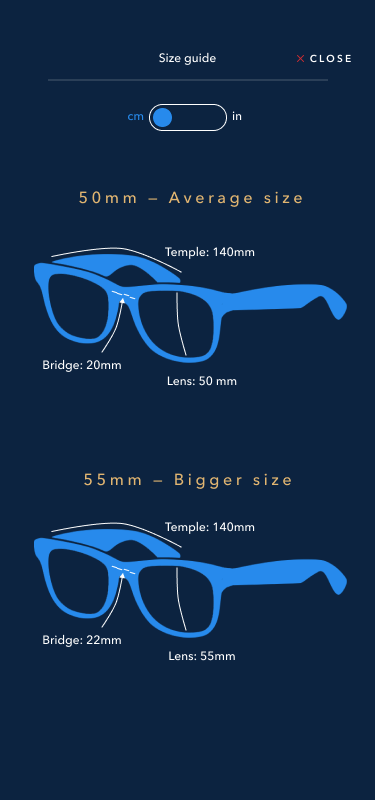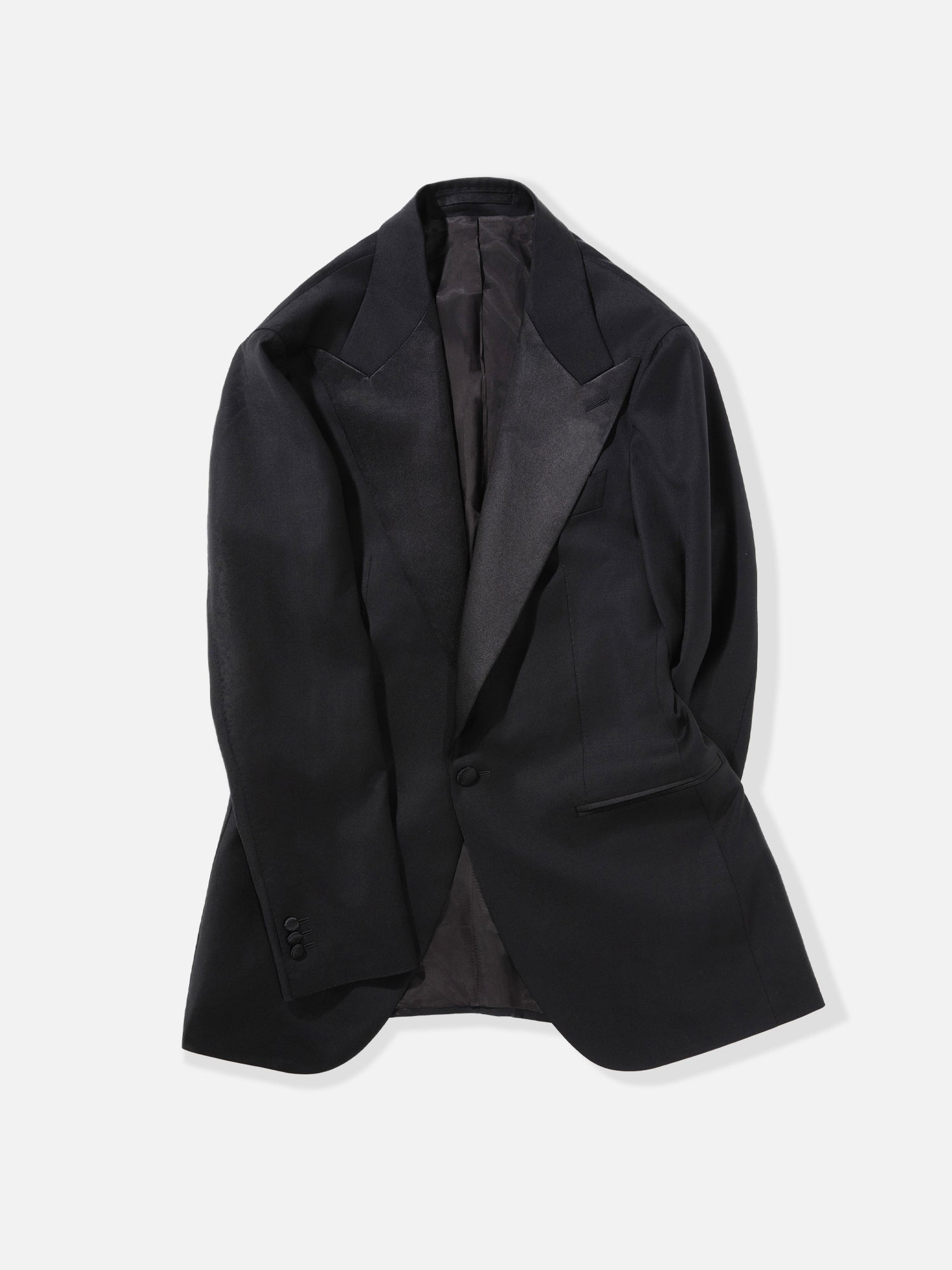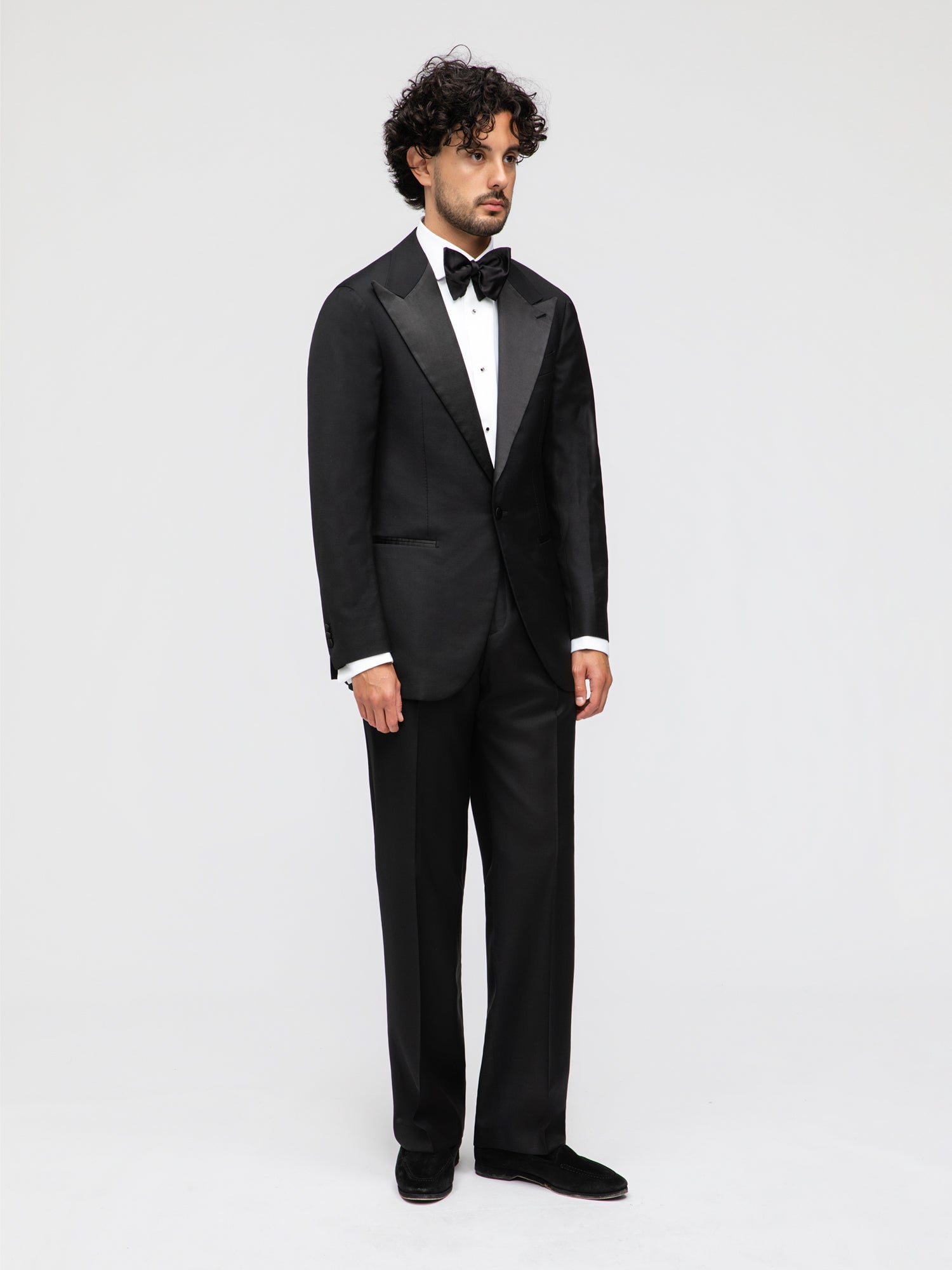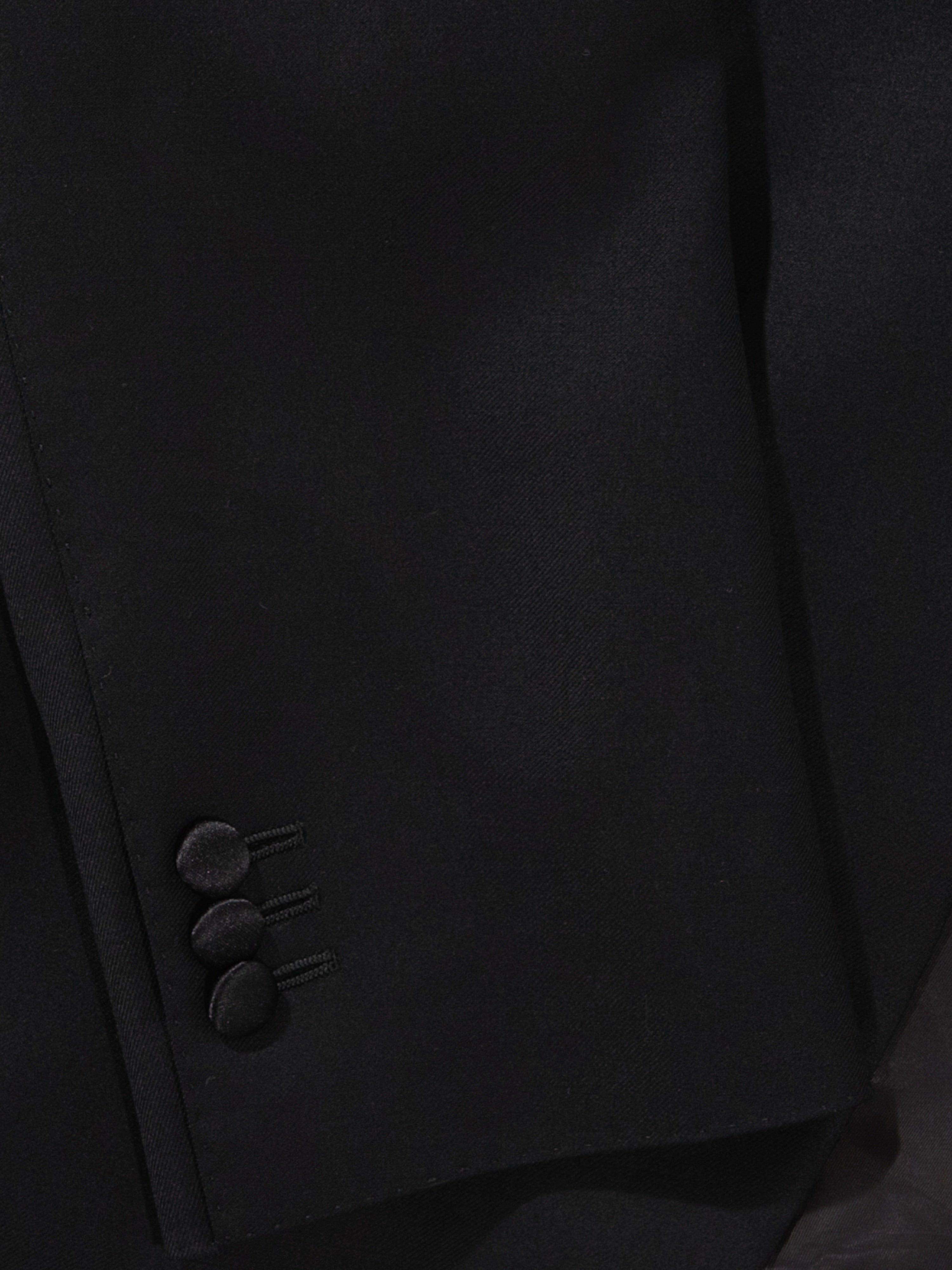Black Wool Tuxedo Jacket (SB)
Black Wool Tuxedo Jacket with single-breasted, one-button closure and wide silk lapels. Tailored fit with jetted pockets and unconstructed shoulders for a refined, formal silhouette.
Regular price
4 399 kr
4 399 kr
Sale
Close

/ Size guide
Use the switch below to display measurements in centimeter or inches.
Have any further questions about fit? Book an appointment with one of our product specialists, and we'll be happy to help.
You can also write to us in the Chat.
Black Wool Tuxedo Jacket with single-breasted, one-button closure and wide silk lapels. Tailored fit with jetted pockets and unconstructed shoulders for a refined, formal silhouette.
DETAILS & FEATURES
- — Single Breasted (1 button)
- — Peak Lapels (12 cm / 4.7 inches)
- — Natural, Unconstructed Shoulder
- — Half Canvas
- — Boat Shaped Chest Pocket
- — Jetted Pockets
- — No Ticket Pocket
- — Double Vents
- — Fully Lined
- — AMF Stitching (2 millimeter)
- — Milanese Lapel Buttonhole (Left side)
- — 3 kissing sleeve buttons, fully functioning
FABRIC & MATERIALS
FABRIC: WORSTED WOOL
COMPOSITION: 100% WOOL
WEIGHT: 280 GRAM
COLOUR: BLACK
BUTTONS: HORN BUTTONS
SEASON: FOUR SEASON
CARE & WASHING
WASHING: DRY CLEAN ONLY
WASHING MACHINE: NO
IRONING: YES
STEAMING: YES
GENERAL GUIDE: STEAM AFTER EACH WEAR
DELIVERY TIME
Estimated delivery time: 3-5 days. To countries within the European Union, we ship with UPS or DHL. To the United States, Canada – and others – we ship with FedEx International. All shipments are fully trackable.
Please note: delivery times may vary depending on the delivery address. Custom made products are produced after you have placed your order, which means the delivery time is estimated between 3-5 weeks.
SIZING INSTRUCTIONS
Model is 6' 04" / 184 cm, and is wearing a size 50 (EU)







DETAILS
- — Single breasted 1 button
- — Half canvas
- — Unconstructed shoulder
- — Peak lapels
- — Fully lined
- — 3 functioning sleeve buttons


FABRIC
All-season wool, durable and naturally resistant to creasing.


ORIGIN
Woven from soft Australian Merino Wool.
New to Custom Made? Press below to get started
GET STARTEDAlready have saved sizes? Log in below
LOGIN FOR SAVED SIZES
I HAVE A JACKET THAT FITS ME WELL
Use measurements from a jacket you already like.

I WANT TO START FROM SCRATCH
Use your body measurements and tell us how you like it to fit.
LOGIN FOR SAVED SIZES
Login if you have an account with us where your measurements are stored from previous orders:
JACKET MEASUREMENTS
Select a jacket size that is your “Base size”, and then make adjustments by pressing plus or minus.

STEP 1:
Place the fully buttoned jacket face up on a flat surface, with the collar pointing upward and the sleeves resting naturally. Smooth out any wrinkles or folds using your hands to ensure the fabric lies flat.

STEP 2:
Start at the top of the armhole seam—aligned with the midpoint of the shoulder—and measure straight down along the center of the sleeve to the end of the cuff.
IMPORTANT:
Keep the measuring tape slightly curved (follow the shape of the sleeve).
ADVANCED SIZE OPTIONS Show Hide

If the jacket collar is too low, a noticeable "collar gap" between the jacket collar and the shirt collar appears on both the sides of the neck. This adjustment will close the gap and bring the collar closer to the neck.

If the jacket collar sits too high, it collapses — casuing a horizontal ridge appears directly below the collar: a so-called ‘collar pleat’. This adjustment will lower the collar and remove the ridge.

If the collar sits well and you’re satisfied with the fit in this area, no alteration is needed.

Shoulders are considered sloped when they angle downward more than usual. This often leads to creasing around the upper back and armhole area. The issue can be corrected by lowering the shoulder angle in the jacket’s construction.

A shoulder is considered squared when it angles upward more than average. This typically causes a horizontal crease across the upper back, wider than the space between the ears. The fit can be improved by increasing the shoulder angle.

If the fit is good in this area, no alteration is needed.

Shoulders are considered sloped when they angle downward more than usual. This often leads to creasing around the upper back and armhole area. The issue can be corrected by lowering the shoulder angle in the jacket’s construction.

A shoulder is considered squared when it angles upward more than average. This typically causes a horizontal crease across the upper back, wider than the space between the ears. The fit can be improved by increasing the shoulder angle.

If the fit is good in this area, no alteration is needed.

If the upper back looks good, but there is still a lapel break in the front chest area, then use this adjustment to increase the front chest of the jacket.

If there is excess fabric in the front chest area, use this adjustment to reduce the front chest. The lapels should lay flat across the chest with an ample amount of fabric to move normally.

If the fit is good in this area, no alteration is needed.

Place the fully buttoned jacket face down on a flat surface, with the collar and sleeves pointing downward. Smooth out any wrinkles or folds using your hands to ensure the fabric lies flat.

Start at the top of the center back seam—where the collar meets the jacket. Measure straight down 15 cm / 6 in and mark this point.

At the 15 cm (6 in) mark, turn the tape measure horizontally and measure from the center seam to the left side seam—where the sleeve meets the back of the jacket.
Keep the measuring tape straight.

Use this alteration if the jacket fits good in the back but is too tight in the front, causing the front panels of the jacket to close.

Use this alteration if the jacket fits good in the back but is too loose in the front, causing the front panels to fly outside the body.

If the fit is good in this area, no alteration is needed.

If the jacket fits well over the stomach but is too loose in the middle of the back, use this tool. Do not confuse this with an erect posture.

If the jacket fits well over the stomach but is too tight in the middle of the back,, use this tool. Do not confuse this with humpback posture.

If the fit is good in this area, no alteration is needed.

If you feel tightness at the underarm that limits arm movement, this adjustment increases the height of the armhole to ease restriction and improve range of motion.

If the armhole appears too low and fabric bunches around the underarm, this adjustment reduces that space for a closer fit. Note that a slight amount of excess fabric is normal to allow for movement. If the jacket rises or pulls upward when you lift your arms to the sides, this adjustment is likely needed.

If the fit is good in this area, no alteration is needed.

If the armhole and upper sleeve feel too tight and restrict movement, this adjustment will enlarge the armhole circumference, allowing for more room and improved mobility in the upper arm. Please note biceps will be sligtly affected.

If the armhole and upper sleeve appear oversized and excess fabric can be pinched in this area, this adjustment will reduce the armhole circumference—resulting in a slimmer fit through the upper arm. Please note biceps will be sligtly affected.

If the fit is good in this area, no alteration is needed.

When the arm's natural position is set too far forward relative to the sleeve, diagonal creases may appear on the front of the upper sleeve. This adjustment rotates the sleeve forward on the jacket to better align with the arm.

When the arm's natural position is is set too far backward relative to sleeve, diagonal creases may appear on the back of the upper sleeve. This adjustment rotates the sleeve backward on the jacket to better align with the arm.

If the fit is good in this area, no alteration is needed.
IMPORTANT:
Keep in mind that a slight amount of excess fabric is normal to allow ease of movement. This change only rotate the sleeve’s position — it does not alter the sleeve’s actual size or height.

STEP 1:
Lay the jacket on a flat surface. Smooth out any wrinkles or folds along the sleeves using your hands to ensure the fabric lies flat.

STEP 2:
Measure straight across the cuff at its widest point—edge to edge—using the sleeve hem as your reference.

Make sure to measure att the edges of the cuff.

If the bottom of the jacket flares out and shows too much overlap at the front when buttoned, this adjustment will trim away the excess fabric and bring the skirt of the jacket closer to the body. This is a common alteration when there’s a large drop between the chest and waist measurements.

If the bottom of the jacket pulls open when buttoned — creating tension or a gap between the front panels — it’s likely that there isn’t enough fabric in the skirt. This can happen when the waist is relatively wide compared to the chest, or if the jacket is cut too slim through the hips. This alteration adds room to the lower front of the jacket, allowing it to sit cleanly and close without straining or flaring open.

If the fit is good in this area, no alteration is needed.

This adjustment adds extra shape to the front of the jacket to accommodate a fuller chest while keeping the waist clean and fitted. The chest dart opens more room across the upper torso so the fabric doesn’t pull or distort, creating a balanced silhouette.

If the fit is good in this area, no alteration is needed.
SIZE PASSPORT NAME:
SELECT BASE JACKET SIZE
SHORT
(between 160 cm — 174 cm)REGULAR
(between 175 cm — 186 cm)LONG
(taller than 187 cm)-

TAILORED FIT
The tailored fit is somewhat V-shaped — meaning that the shoulders are wider, and then the upper waist of the jacket is slightly tapered.
-

CASUAL FIT
The casual fit is more loose throughout the entire jacket — meaning that the shoulders, chest, upper waist and hip are wider. Also, the biceps and sleeve opening are somewhat wider as well.
BODY MEASUREMENTS
Enter your body measurements and fit preference. Our AI-system will suggest garment measurements for you. You can make adjustments by pressing plus or minus.

Stand upright without shoes, back against a wall, with feet together and shoulders relaxed. Measure from the top of the head down to the floor. Use a flat object (like a book) to mark the top of the head, then measure vertically to the ground.
Keep the measuring tape straight.

Wrap the measuring tape around the fullest part of the chest, typically just under the armpits and across the nipples. Keep the tape level and snug, but not tight. Ensure the person is breathing normally — don’t hold breath or puff the chest.
Keep the measuring tape straight.

Measure straight across the back, from the edge of one shoulder (where the arm meets the shoulder) to the other. The tape should follow the natural curve where a jacket’s shoulder seam would sit — not too far forward or down the arm.

Tip: If the person is wearing a well-fitted shirt or jacket, use the visible shoulder seams as reference points. Measure from one seam to the other, straight across the back, as shown in the image. This provides a more accurate guide for jacket construction.
Keep the measuring tape straight.

Wrap the measuring tape around the upper waist — just above the navel and below the ribcage. Keep the tape horizontal, snug, and allow for natural breathing.
Keep the measuring tape straight.

Stand with feet together and wrap the measuring tape around the fullest part of the hips and seat. Keep the tape level and snug, without digging into the body. Make sure pockets are empty and you are standing upright.
Keep the measuring tape straight.

With the arm relaxed and slightly bent at the elbow, measure around the widest part of the upper arm (bicep). Ensure the tape is horizontal and comfortably snug — not tight. Avoid flexing the arm during the measurement.
Keep the measuring tape straight.

Start at the shoulder seam (or the point where the shoulder meets the arm) and measure down the outside of the arm, past the elbow, to the wrist bone. The arm should be slightly bent and the measurement tape as well. Tip: For best accuracy, put on a t-shrt or jacket and use the shoulder seam and wrist bone as visual reference points — This ensures the sleeve will fall correctly when worn.
Keep the measuring tape straight.
ADVANCED SIZE OPTIONS Show Hide

Standard: This body type features a balanced, natural chest shape without significant muscle development. The chest tapers gently into the waist, allowing most jackets to sit cleanly without pulling or gaping. It's the default build many ready-to-wear patterns are based on.

Muscular: Characterized by a fuller, more pronounced chest due to muscle mass, especially in the pectorals. A muscular chest often requires extra allowance in the chest area to prevent tightness across the front and to maintain a clean drape. Tailoring adjustments may be needed to avoid distortion in the jacket’s closure line or pulling at the lapels.

Flat: This build shows little to no protrusion at the midsection. Garments follow the natural taper from chest to waist and sit close to the body without tension. Most tailored fits accommodate this shape with minimal alteration.

Round stomach: A fuller stomach that projects outward from the side view. This shape can cause garments to flare open or ride up if not cut appropriately. Patterns often need additional room in the front waist and hem to allow for a clean, uninterrupted line from chest to hip.
FIT
-

Tailored fit
-

Casual fit

STEP 1:
Place the fully buttoned jacket face up on a flat surface, with the collar pointing upward and the sleeves resting naturally. Smooth out any wrinkles or folds using your hands to ensure the fabric lies flat.

STEP 2:
Start at the top of the armhole seam—aligned with the midpoint of the shoulder—and measure straight down along the center of the sleeve to the end of the cuff.
IMPORTANT:
Keep the measuring tape slightly curved (follow the shape of the sleeve).
ADVANCED SIZE OPTIONS Show Hide

If the jacket collar is too low, a noticeable "collar gap" between the jacket collar and the shirt collar appears on both the sides of the neck. This adjustment will close the gap and bring the collar closer to the neck.

If the jacket collar sits too high, it collapses — casuing a horizontal ridge appears directly below the collar: a so-called ‘collar pleat’. This adjustment will lower the collar and remove the ridge.

If the collar sits well and you’re satisfied with the fit in this area, no alteration is needed.

Shoulders are considered sloped when they angle downward more than usual. This often leads to creasing around the upper back and armhole area. The issue can be corrected by lowering the shoulder angle in the jacket’s construction.

A shoulder is considered squared when it angles upward more than average. This typically causes a horizontal crease across the upper back, wider than the space between the ears. The fit can be improved by increasing the shoulder angle.

If the fit is good in this area, no alteration is needed.

Shoulders are considered sloped when they angle downward more than usual. This often leads to creasing around the upper back and armhole area. The issue can be corrected by lowering the shoulder angle in the jacket’s construction.

A shoulder is considered squared when it angles upward more than average. This typically causes a horizontal crease across the upper back, wider than the space between the ears. The fit can be improved by increasing the shoulder angle.

If the fit is good in this area, no alteration is needed.

If the upper back looks good, but there is still a lapel break in the front chest area, then use this adjustment to increase the front chest of the jacket.

If there is excess fabric in the front chest area, use this adjustment to reduce the front chest. The lapels should lay flat across the chest with an ample amount of fabric to move normally.

If the fit is good in this area, no alteration is needed.

Place the fully buttoned jacket face down on a flat surface, with the collar and sleeves pointing downward. Smooth out any wrinkles or folds using your hands to ensure the fabric lies flat.

Start at the top of the center back seam—where the collar meets the jacket. Measure straight down 15 cm / 6 in and mark this point.

At the 15 cm (6 in) mark, turn the tape measure horizontally and measure from the center seam to the left side seam—where the sleeve meets the back of the jacket.
Keep the measuring tape straight.

Use this alteration if the jacket fits good in the back but is too tight in the front, causing the front panels of the jacket to close.

Use this alteration if the jacket fits good in the back but is too loose in the front, causing the front panels to fly outside the body.

If the fit is good in this area, no alteration is needed.

If the jacket fits well over the stomach but is too loose in the middle of the back, use this tool. Do not confuse this with an erect posture.

If the jacket fits well over the stomach but is too tight in the middle of the back,, use this tool. Do not confuse this with humpback posture.

If the fit is good in this area, no alteration is needed.

If you feel tightness at the underarm that limits arm movement, this adjustment increases the height of the armhole to ease restriction and improve range of motion.

If the armhole appears too low and fabric bunches around the underarm, this adjustment reduces that space for a closer fit. Note that a slight amount of excess fabric is normal to allow for movement. If the jacket rises or pulls upward when you lift your arms to the sides, this adjustment is likely needed.

If the fit is good in this area, no alteration is needed.

If the armhole and upper sleeve feel too tight and restrict movement, this adjustment will enlarge the armhole circumference, allowing for more room and improved mobility in the upper arm. Please note biceps will be sligtly affected.

If the armhole and upper sleeve appear oversized and excess fabric can be pinched in this area, this adjustment will reduce the armhole circumference—resulting in a slimmer fit through the upper arm. Please note biceps will be sligtly affected.

If the fit is good in this area, no alteration is needed.

When the arm's natural position is set too far forward relative to the sleeve, diagonal creases may appear on the front of the upper sleeve. This adjustment rotates the sleeve forward on the jacket to better align with the arm.

When the arm's natural position is is set too far backward relative to sleeve, diagonal creases may appear on the back of the upper sleeve. This adjustment rotates the sleeve backward on the jacket to better align with the arm.

If the fit is good in this area, no alteration is needed.
IMPORTANT:
Keep in mind that a slight amount of excess fabric is normal to allow ease of movement. This change only rotate the sleeve’s position — it does not alter the sleeve’s actual size or height.

STEP 1:
Lay the jacket on a flat surface. Smooth out any wrinkles or folds along the sleeves using your hands to ensure the fabric lies flat.

STEP 2:
Measure straight across the cuff at its widest point—edge to edge—using the sleeve hem as your reference.

Make sure to measure att the edges of the cuff.

If the bottom of the jacket flares out and shows too much overlap at the front when buttoned, this adjustment will trim away the excess fabric and bring the skirt of the jacket closer to the body. This is a common alteration when there’s a large drop between the chest and waist measurements.

If the bottom of the jacket pulls open when buttoned — creating tension or a gap between the front panels — it’s likely that there isn’t enough fabric in the skirt. This can happen when the waist is relatively wide compared to the chest, or if the jacket is cut too slim through the hips. This alteration adds room to the lower front of the jacket, allowing it to sit cleanly and close without straining or flaring open.

If the fit is good in this area, no alteration is needed.

This adjustment adds extra shape to the front of the jacket to accommodate a fuller chest while keeping the waist clean and fitted. The chest dart opens more room across the upper torso so the fabric doesn’t pull or distort, creating a balanced silhouette.

If the fit is good in this area, no alteration is needed.





